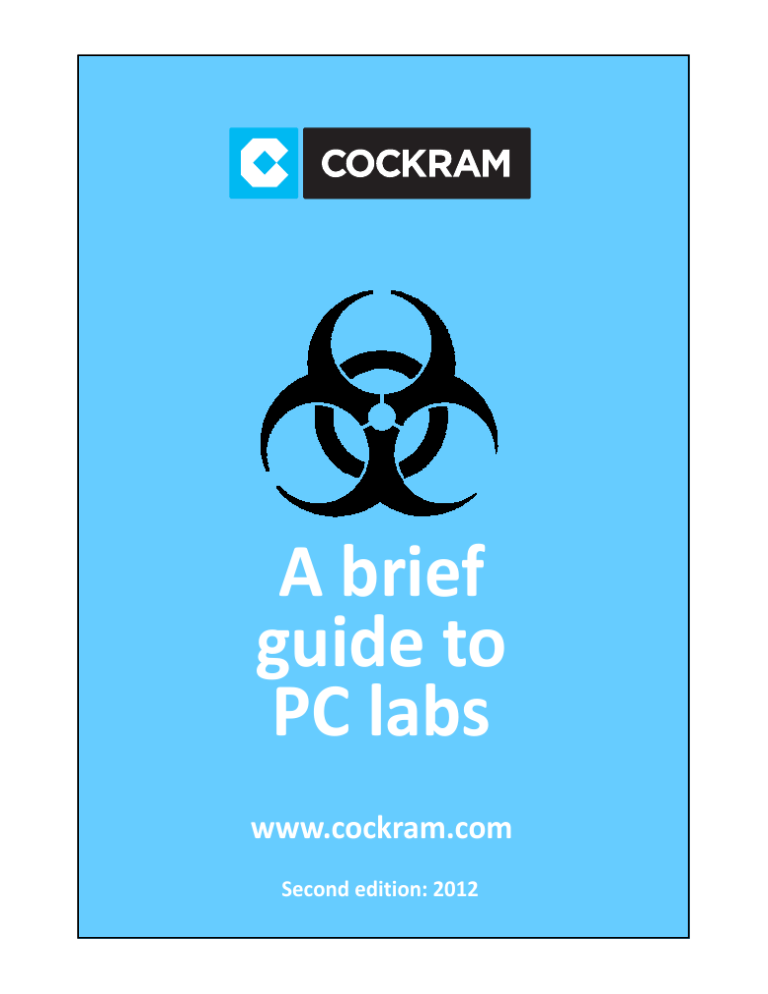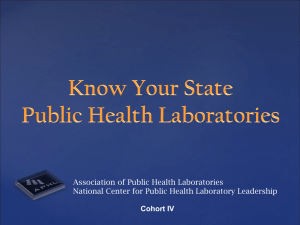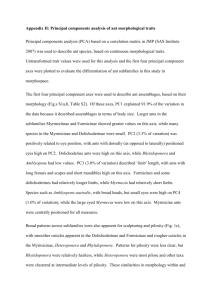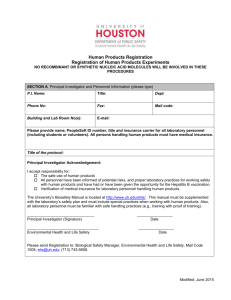PC book - Cockram

A
brief
guide
to
PC
labs
www.cockram.com
Second edition: 2012
PC3 Laboratory, School of Veterinary Science, James Cook
University.
Completed in 2010 by Cockram Construction.
2
Cockram’s reputation for delivering facilities of the highest standards in construction and technical excellence is well deserved.
Due to our proven expertise in the areas of laboratory and bio ‐ pharmaceutical facilities, in the fields of clean room design, construction, commissioning and validation, we have seen our operations expand globally as a result of client demand from around the world.
Cockram’s team includes construction and technical professionals who have considerable experience in the delivery of Physical Containment laboratories (PC
Laboratories).
This guide has been prepared to share some insights into the requirements for the design, construction and testing of physical containment laboratories.
This is not an exhaustive technical resource for PC laboratory design, construction and testing.
It is simply to provide a useful resource within Cockram and also externally, to industry professionals who are directly involved in the design, delivery and ongoing management of this type of facility.
We hope that you find this guide to be of value as you plan for your next PC laboratory project, and we encourage you to contact
Cockram Construction directly if we can be of assistance to you in the planning, design, construction and facility delivery processes.
Mal Batten
Managing Director
Cockram Construction mal.batten@cockram.com
3
What
is
‘PC’
(physical
containment)?
4
Physical containment or ‘PC’ is a reference in the Aus ‐ tralian/New Zealand Standards (AS/NZS 2243.3:
2010—Safety in laboratories ‐ microbiological safety and containment) to the level of risk associated with microbiological work.
This recognises four levels of physical containment.
They are:
PC 1:
Practices & equipment appropriate for student and undergraduate teaching laboratories
Risk Group 1 as per the Standard
Work that may be carried out on an open bench
Organisms not known to cause disease in healthy adults
PC 2:
Practices & equipment applicable for clinical, diag ‐ nostic, industrial, teaching, and related purposes
Risk Group 2 as per the Standard
Work is with micro organisms which may be pre ‐ sent in the community
Micro organisms which may be associated with animal, plant or human disease of moderate sever ‐ ity
Work which may be carried out on an open bench
with good microbiological technique
If there is significant risk from aerosols, a biological safety cabinet shall be used
5
PC 3:
Practices & equipment applicable for clinical and diagnostic work, includes indigenous or exotic micro organisms
Risk Group 3 as per the Standard
Risk of serious infection to humans, animals and plants
Safeguards such as airlocks, door seals, security, decontamination, pressure steam sterilisation, waste treatment, alarms & additional communica ‐ tion systems
PC 4:
Practices & equipment applicable for dangerous micro organisms posing a high individual risk of life ‐ threatening disease
Risk Group 4 as per the standard
Life ‐ threatening diseases that may be spread to the community
Isolated from other laboratories
Clothing change and shower rooms contiguous to ventilation system
Liquid waste decontamination required
Work completed using a Class III biosafety cabinet
(exhausts venting outside the laboratory) or fully encapsulated positive pressure suits
6
Summary table of PC laboratory risk gradings
Level PC1 PC2 PC3 PC4
Risk within the facility
Low Low to moderate
High
Risk outside the facility (to broader com ‐ munity)
Example
Low Limited with low risk of spread
Limited
Non pathogenic bacteria
Hepatitis, salmonella
SARS,
Yellow fever.
High
Readily spread
Hendra virus,
Ebola virus
PC4 laboratory, Victorian Infectious Diseases Research
Laboratory, by Cockram Construction.
7
Design
and
regulatory
authorities
Fully welded stainless steel exhaust ducts with carbon filtration, installed by
Cockram.
Complex, intense negative pressure systems such as this are typical of many PC4 or high end PC3 projects.
8
The standards required of PC laboratories are rigorous, and post construction certification of the facility may not be achieved if sufficient steps aren’t taken during the design and construction phases to identify the requirements for certification.
In our experience, the following provides a useful checklist for client teams when preparing to deliver a
new PC laboratory:
1.
Engage experienced architectural and engineering teams, suited to the scale and complexity of the project
2.
Consult early with the Australian Quarantine &
Inspection Service (AQIS) (where applicable)
3.
Consult early with the Office of the Gene
Technology Regulator (OGTR)
4.
Understand ALL of the applicable standards, and any foreshadowed changes
5.
Correct classification within each QC or PC level is essential
6.
Mechanical and electrical specifications will vary on interpretation
7.
Be aware of latest equipment options
9
Construction
techniques
Vinyl floors are laid to avoid sharp angles and recesses where contaminants can be trapped and floors are sealed to
10
minimise any leakage.
This brief summary of construction techniques critical for the correct delivery and certification of PC labs is not intended as an exhaustive checklist.
Rather, it is intended to give readers an insight into some of the design and construction features of PC labs that
deserve close attention.
It is also important to understand that PC3 and PC4 laboratories must be physically separated from other areas and that specific signage is required for PC
laboratories.
Walls & Ceilings
There are generally three types of material used:
Insulated Panel
Multi ‐ layered plasterboard
Masonry
Cockram typically prefer to work with insulated panels because they can be sealed more efficiently than alternative materials.
Extra precautions are
required if working with plasterboard or masonry.
11
Above and below.
Prior to installing walls, base channels should be thoroughly coated with polyurethane sealant.
12
Above and below.
Pictured are samples used on the University of
Auckland PC3 laboratory project by Cockram.
The images illustrate the panels, joints and sealing techniques which were used in lieu of the original plasterboard design.
13
Doors and windows
For PC labs, all doors and windows are generally of stainless steel construction.
They are typically provided by a specialist manufacturer and are designed and manufactured to suit the particular level of PC laboratory they are intended for.
Doors and windows are generally interlocked and alarmed.
Higher grade PC labs (PC3 and PC4) require very high standards of lab entry doors and door sealing systems
(such as pneumatic seals).
Air lock doors to PC3 laboratory completed by Cockram in 2010.
14
Above: A pass through de ‐ contamination unit fitted in a
PC3 area requires a sophisti ‐ cated barrier seal.
Left: Air lock doors, such as this one installed at Auckland Univer ‐ sity by Cockram, are highly complex installations which require particular care and specialist expertise.
15
Access to PC labs is typically controlled via push button controls
(above) or electronic swipe cards which restrict unauthorised access.
Windows (below) are sealed and doors are alarmed to alert for any falls in pressure which may affect the containment capabilities of the laboratory.
16
Joinery
Joinery for PC labs must be designed with ease of cleaning and hygiene standards top of mind.
Joinery should be smooth and impervious to moisture, chemicals or cleaning agents.
Bench tops must not
have open seams.
Joinery should not contain any enclosed spaces or voids where fumigants or contaminants may be trapped.
Joinery must be designed with ease of cleanliness foremost in mind.
PC labs will also contain a variety of specialised equipment and laboratory users are trained in maintaining both equipment and surfaces etc to high standards of cleanliness.
17
Mechanical systems
PC laboratories require a constant negative internal pressure relative to external air pressure.
This is needed to maintain the containment of the laboratory’s micro organisms (to prevent escape).
This constant negative pressure reflects on the design of all mechanical systems where there is a penetration from outside to inside the laboratory.
PC2 laboratories have no mandated minimum inward airflow pressure differential.
PC3 and PC4 laboratories require a minimum of 50 Pascals and 25
Pascals between adjoining rooms of the facility (a pressure cascade).
The use of bubble style dampers are required in PC3 and PC4 facilities.
All ductwork must be pressure tested using a duct work integrity test (pressurised to 1,000 Pa with zero leakage over three minutes between the lab room and the HEPA filter canisters for PC3 and PC4 labs).
Fully welded stainless steel construction is often a require ‐ ment of PC lab mechanical ser ‐ vices.
18
PC labs also require dedicated vacuum systems and no recirculation of air is allowed to non containment areas.
Stand alone HVAC systems are usually used.
HEPA filter boxes need to be pressure tested with a zero leakage requirement and have the ability to withstand a pressure of 2,500 Pa.
Air movement within the PC area should be from the cleanest to the potentially more contaminated areas.
250 micron screens fitted to PC laboratory exhaust (left) and air supply (right).
Alarms and monitoring systems are required to maintain vigilance over the control of negative pressures of PC laboratory environments.
19
In summary, typical mechanical systems requirements of PC laboratories include:
HEPA filtration
Interlocked air supply and exhaust to ensure inward flow
Fully welded stainless steel construction
100% exhaust to atmosphere
Fumigation regimes
Labs should also feature audible alarm systems and pressure displays so that the negative pressure status is constantly monitored.
Welded stainless steel ductwork.
20
Hydraulic systems
Hydraulic systems within PC laboratories should be designed with the following in mind:
Hands ‐ free operation at washing stations
Safety showers – no floor waste
Back ‐ flow prevention (use of R.P.Z.
devices)
Fully sealed/welded trade waste pipe systems and double containment pipe systems
Approved waste regime
Waste removal is performed frequently via a sealed
container.
Part of the waste decontamination system for a PC3 Lab completed by Cockram in 2010.
21
Above: Waste treatment via a sealed container.
Below: HEPA filter boxes installed in a plant room adjacent to a PC3 laboratory.
22
Electrical systems
Electrical systems design for PC labs, as with hydraulic systems, should provide for the following:
Back ‐ up power for the ventilation system.
This is strongly recommended
Back ‐ up power for Biological Safety Cabinets
(BSCs)
Ducted systems
Warning systems – designed for both occupants and equipment.
Penetrations associated with electrical systems should be minimal, sealed and have a single point of entry for each cable.
Complex electrical services are a feature of PC lab design.
23
Laboratory equipment
PC laboratories feature advanced biological equipment and every laboratory will feature different equipment depending on the nature of its use.
Biological safety to lab users is the one constant irrespective of lab equipment.
As a general rule:
Autoclaves must be fitted with bioseals in PC3 and
PC4 laboratories
For PC4 labs, protective suits with air breathing systems and/or isolators are required
Positioning of BSC’s should bear in mind supply and return air locations
Provision should be made for automatic shutdown of sterilizers
Identify equipment requiring back ‐ up power— freezers, ovens , etc
User safety is a constant and paramount concern.
24
Penetrations
and
seals
25
The greatest challenge with wall, floor or ceiling penetrations in a physical containment environment is obvious: every penetration increases the risk of an
air leak.
PC3 and PC4 labs cannot have air leaks greater than 2
litres per second.
Trying to find a leak and rectify it post construction can be arduous and expensive.
This means that every penetration of every type— electrical, hydraulic, mechanical, fire services etc— must be fully sealed.
It is advisable that penetrations through surfaces are cut as close as possible to the services to be installed so that less caulking is
required.
It is also advisable to investigate all approaches that potentially remove or eliminate penetrations.
Screwed ceiling light fixtures, for example, are in our experience often specified in drawings but alternatives that eliminate the risk of air leaks through screw holes are available and are preferable.
26
The room pressure test for air leaks in PC3 & PC4 laboratories is 200 Pascals with an allowable leakage of 120 litres per minute.
The approach in summary is therefore two fold:
1.
Minimise penetrations wherever possible.
2.
Pay close attention to detail for any required penetrations.
The examples illustrated on the following pages are generally those associated with PC3 laboratory environments but serve to highlight a variety of approaches and construction techniques suited to the standards required generally of physical containment laboratories.
The goal of a fully sealed laboratory is why penetrations are kept to a minimum and where required, careful attention is paid to sealing these penetrations.
27
Above: A typical penetration sleeve for hydraulic services.
Below: Thoroughly coat both sides of the wall with polyurethane sealant prior to installing the stainless steel sleeve.
28
Above and left: Care should be taken with penetrations associated with gases and compressed air.
Below: Even simple installations like lab coat hooks should avoid any penetrations created by screws and instead form part of solid plates which are fixed to walls with poly ‐ urethane sealant and double sided tape.
29
Above: Electrical and communication systems must also take into account the importance of sealing the penetration into the PC labo ‐ ratory.
Below left: Penetrations details for hydraulic services.
Below right: typical penetration sleeve.
30
Above: Laboratory gas valves and regulators.
Note the sophisti ‐ cated nature of the fitting which involves zero wall penetrations.
Below: Fumigation port detail for a PC3 Laboratory.
Ports are sand ‐ wiched between sealed stainless steel plates either side of the wall.
31
Avoiding
mistakes
32
With physical containment laboratories, the most obvious and most concerning error can be if the lab does not hold pressure within the room pressure test ‐
ing acceptance criteria stipulated by the regulator.
This can result from design or delivery errors, the wrong choice of components or the use of subcon ‐ tractors or suppliers who are not closely supervised by experienced containment laboratory builders.
It can be very difficult, if not impossible to locate— let alone repair—a leak if a lab does not hold pressure within the acceptable parameters (the permissible leakage cannot exceed 2 litres per second at a room
pressure of 200pa).
In fact, Cockram have in the past been called onto projects where other contractors have not succeeded with sealing and certification standards, meaning the client was required to rebuild new containment labs using the correct construction techniques.
33
We believe we have built more PC labs in Australia than any other builder.
Our checklist of things to watch for to avoid mistakes is based on experience
and includes the following:
Choose an architect/design team who have successfully detailed physical containment
laboratories
Choose a builder who has experience in the successful delivery of a physical containment lab facility
Select services contractors and other contrac ‐ tors involved with the laboratory envelope who have previously worked on PC facilities
Become as knowledgeable as you can commissioning and what is involved
about
Ask
Be
a lot of prepared seemingly
to show
self your
evident questions ignorance
Think in first principles about what the sys ‐ tems are needing to achieve
Ensure all contractors are specifically inducted into the works and the nature of the PC re ‐ quirements
Always focus on detail, detail, detail.
34
Contact
the
leadership
team
If you need some advice or have some further ques ‐ tions, please don’t hesitate to contact the following people.
Darren Milne
Operations Manager Australia
0418 101 181 darren.milne@cockram.com
Michael Read
New South Wales State Manager
0400 013 458
michael.read@cockram.com
Chris Meade
Queensland State Manager
0439 037 017 chris.meade@cockram.com
Michael Clemenger
Victorian State Manager
0407 535 672
michael.clemenger@cockram.com
Greg Mithen
WA State Manager—Esslemont Cockram
0417 644 647 greg.mithen@cockram.com
35
Completed early 2012, the $43 million Elizabeth Macarthur Agricultural
Biosecurity (EMAI) Upgrade Project designed by S2F for NSW Public Works
(Department of Finance and Services) is of significant importance to Australia as a first line of defence to a catastrophic disease such as an outbreak of foot and mouth disease.
The project features two new buildings with 1,625 sqm of
Physical Containment (PC) or Quarantine Containment (QC) standards PC2/QC2 laboratories, and 775 sqm of PC3/QC3 laboratories, plus the upgrade of existing infrastructure and trade waste treatment and disposal system, as well as the refurbishment of six (6) existing laboratory buildings totalling 600sqm 36
PC2 or QC2 standard.
Selection
of
PC
laboratories
by
Cockram
PC4.
Victorian Infectious Dis ‐ eases Research Laboratory.
Western Health Care Network.
$4.4million.
1998.
PC3.
Goddard Building TERN &
Insectary, University of Queen ‐ sland.
$1.7
million.
2010.
PC3.
Faculty of Medicine and
Health Science, University of
Auckland, NZ.
$2.3
million.
PC3 & PC2.
Illawarra Health and Medical Research Institute,
Wollongong.
$22 million.
2010.
37
PC3.
School of Veterinary Sci ‐ ence.
JCU Townsville.
$955,000.
2010.
PC3.
Institute of Health & Bio ‐ medical Innovation.
QUT.
$813,000.
2010.
PC3 & PC2; QC3 & QC2.
Eliza ‐ beth Macarthur Agricultural
Institute, Biosecurity Upgrade,
NSW.
$43 million.
2012.
PC3 & PC2.
SmithKline
Beecham Biologicals, Shang ‐ hai, China .
PC2.
Monash Health Research
Precinct.
$14.8
million.
2005.
38
PC2 .
Monash University STRIP.
$70.7million.
2009.
PC2.
Deakin University Shared
Laboratories.
$11.3
million.
2010.
PC2.
CSL Building 4 HVB – R&D
Refurbishment.
$6.9
million.
2009.
PC2.
Blacktown Clinical School,
Education and Research Cen ‐ tre.
$16 million.
2011.
PC2.
Cancer Biology Imaging
Facility, Institute for Molecular
Bioscience University of
Queensland.
$545,000.
2009.
39
PC2 + Cyclotron.
Centre for
Advanced Imaging, University of Queensland.
$32.5
million.
2012.
PC2.
Victorian Agribiosciences
Centre.
$16.5
million.
2005.
PC2 + Class 100 & Class
10,000.
Melbourne Centre for
Nanofabrication.
$13.5
million.
PC2.
Australian Red Cross
Blood Service—Melbourne
Processing Centre.
$57.1
mil ‐ lion.
2011.
40
Melbourne Office
Ground Floor
675 Victoria Street
Abbotsford, Vic 3067
Tel: +61 3 8862 8888
Fax: +61 3 8862 8900
Sydney Office
Level 2, 500 Pacific Highway
St Leonards NSW 2065
Tel: +61 2 9818 6099
Fax: +61 2 9818 6155
Brisbane Office
Unit 2, William Jolly Place
309 North Quay
BRISBANE QLD 4000
Tel: 07 3229 0288
Fax: 07 3229 5827
Perth Office
57 McCoy Street
Myaree WA 6154
Tel: +61 8 9330 2344
Shanghai Office
Suite 14E, Hua Min Empire Plaza,
No.
728 Yan An (West) Road,
Shanghai, 200050,
People’s Republic of China
Tel: +86 21 5238 3666
Fax: +86 21 5239 7318
Tianjin Office
A3 ‐ 705, TEDA New Skyline,
No.
12 Nanhai Road,
Tianjin, 300457,
People’s Republic of China
Tel: +86 22 6628 3452/53
Fax: +86 22 6628 3451
Suzhou Office
Room 1216, Genway Building,
No.
188 Wangdun Road,
Suzhou Industrial Park,
Suzhou, 215123,
People’s Republic of China
Tel: +86 512 6660 7400
Fax: +86 512 6660 7401
Guangzhou Office
Room 2112, China Shine Plaza,
No.
9 Linhe (West) Road,
Guangzhou, 510610,
People’s Republic of China
Tel: +86 20 3801 0245/46
Fax: +86 20 8527 0717
India
India Private Limited
Level 4, Dynasty Business Park,
Andheri – Kural Road.
Andheri (East)
Mumbai – 400 059
Telephone: +91 22 4030 9118
Kalamazoo ‐ Michigan
8175 Creekside Drive
Suite 260, Portage, MI 49024
Tel: +269 321 5068
Fax: +269 321 5069
Puerto Rico Office
Metro Office Park
Street 1, Building 11, Suite 106
Guaynabo PR 00968 ‐ 1705
Tel: +1 787 273 2277
Fax: +1 787 273 2279
41
www.cockram.com
Australian Red Cross Blood Service, Melbourne Processing Centre, completed in
2011 by Cockram Construction.
The ARCBS facility included extensive
42 laboratory areas.







